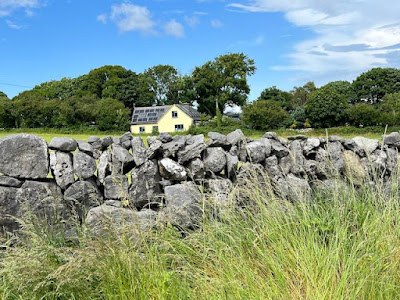After visiting the Cliffs of Mohar, we drove along the coast for a short time. You can see the puffs of clouds that I noted were visible throughout the day on the horizon. Little cotton balls.
I was quite fascinated by the different types of stone fences. I wanted to get a picture of the ones with sideways stacked slabs of slate, but couldn't manage it. They are more common out in the grazing lands than around homes.

fI've never seen so many stones in my life!
Our trip to Dungaire Castle took us through The Burren region south of Galway - its very rocky hill tops that look quite different from the nearby regions.
The pictures don't really do it justice.
The roads were narrow, but at least had two full lanes on the return trip which was not the case as we drove out to the cliffs!
Accurate description. See map below.
Storms were brewing of the hills, but we didn't get too much rain.
There were some large pieces of farm equipment on the road!
One of my favorite photos of the day. Dungaire castle
A heron in the tide.
Its not really a fortification. The 'tower house' style was popular on the continent in the 1500s. This was built in 1520. The land around it at the time was heavy woods and bogs, so travel was largely done by sea, trading up the coast to Galway.
This is the vaulted ceiling of the first floor. You can see imprints in the mortar of the wickerwork that was used to hold the stone in place as the arch was being completed. The ground floor was used to store produce, barrels of water, wine, salted meat and fish. The thick walls helped keep the space a consistent temperature.
This is the width of the exterior wall. Nearly 6 feet thick!
 |
The spiral stone staircase wound all the way to the top. I think I made 10+ circuits to reach all five floors.
Legend has it that one day 150 poets showed up on King Guaire's doorstep. He hosted them with banquets every night and they offered poems and entertainment for a year and a half. Interesting legend. Today they host banquets (public and private). They were setting the table for the evening when we arrived.
In the 1600's the castle was 'modernized' when chimney's were added to an outer wall and glass windows were installed.
In 1954, the castle, which had fallen into ruin, was purchased by Lady Christobel Amptill from England. She added on a modern kitchen with a bedroom above (which is now the gift shop). The top left (above) has a high peaked ceiling and comfy furniture. There are new(ish) skylights in the ceiling and an exit to the roof where you can walk around 360.
View of the bay from the roof top.
The roof has 'machicolations' - holes in the floor that extend beyond the wall so hot oil or objects can be dropped on people outside the walls.
We made our way back to Galway and wandered around looking for a place for dinner. We settled on Italian. It was delicious.
After dinner we did an "adventure lab" - similar to my geocache app, but you don't have to find a hidden object. You go to different locations and answer a question about the site. Usually they come with 5 stops and are designed to tour you around an area. One of our stops was at St Nicholas Church in the Latin Quarter.
We passed this statue of Yeats along the way.
Another site was in the park. This sculpture represents the Galway Hooker style sailing boat.
We were also taken to the Galway cathedral. It was 9 pm at this point and it wasn't open to see the inside, sadly.
This was on the river. There were fishermen wading and casting. In the center of the spillway is a spawning ladder. Salmon run up the river each year.
This grand facade of a building near by hid a much smaller building behind.
This is a side view of the big facade with the smaller actual building.
Lovely flowers and sky
Spanish arch
Just below 34 on the image, you can see 4 arches. This is Spanish arch and was part of the defense of the harbor in the 1600's. The water came right up to the walls.
1800's
This is the arch today. Only two of the four remain.









































No comments:
Post a Comment